FIAT DOBLO PANORAMA 2015 2.G Owners Manual
Manufacturer: FIAT, Model Year: 2015, Model line: DOBLO PANORAMA, Model: FIAT DOBLO PANORAMA 2015 2.GPages: 323, PDF Size: 47.13 MB
Page 181 of 323
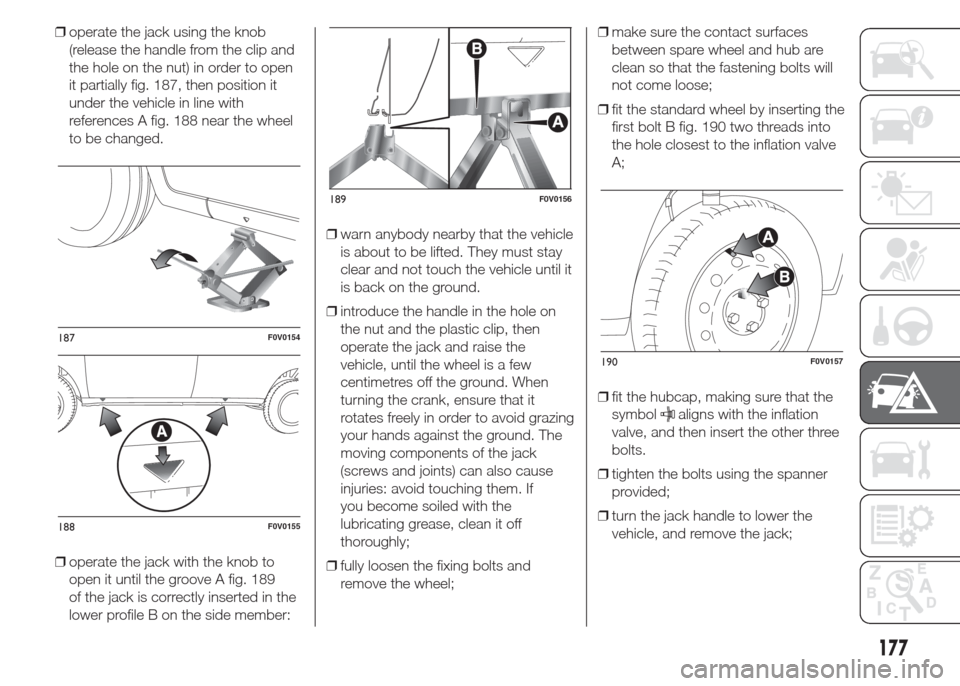
❒operate the jack using the knob
(release the handle from the clip and
the hole on the nut) in order to open
it partially fig. 187, then position it
under the vehicle in line with
references A fig. 188 near the wheel
to be changed.
❒operate the jack with the knob to
open it until the groove A fig. 189
of the jack is correctly inserted in the
lower profile B on the side member:❒warn anybody nearby that the vehicle
is about to be lifted. They must stay
clear and not touch the vehicle until it
is back on the ground.
❒introduce the handle in the hole on
the nut and the plastic clip, then
operate the jack and raise the
vehicle, until the wheel is a few
centimetres off the ground. When
turning the crank, ensure that it
rotates freely in order to avoid grazing
your hands against the ground. The
moving components of the jack
(screws and joints) can also cause
injuries: avoid touching them. If
you become soiled with the
lubricating grease, clean it off
thoroughly;
❒fully loosen the fixing bolts and
remove the wheel;❒make sure the contact surfaces
between spare wheel and hub are
clean so that the fastening bolts will
not come loose;
❒fit the standard wheel by inserting the
first bolt B fig. 190 two threads into
the hole closest to the inflation valve
A;
❒fit the hubcap, making sure that the
symbol
aligns with the inflation
valve, and then insert the other three
bolts.
❒tighten the bolts using the spanner
provided;
❒turn the jack handle to lower the
vehicle, and remove the jack;
187F0V0154
188F0V0155
189F0V0156
190F0V0157
177
Page 182 of 323
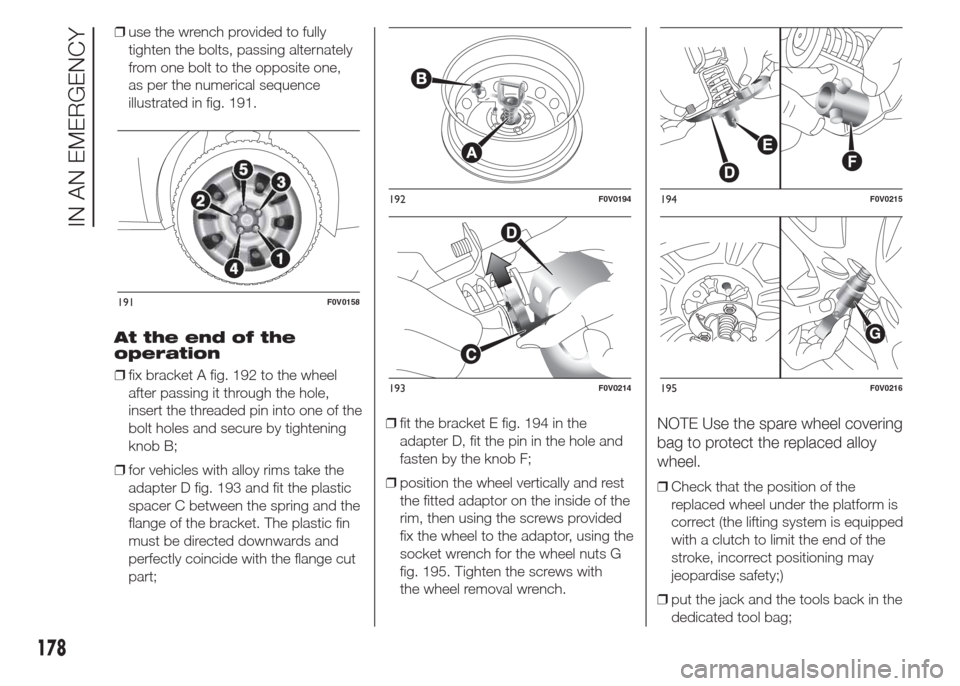
❒use the wrench provided to fully
tighten the bolts, passing alternately
from one bolt to the opposite one,
as per the numerical sequence
illustrated in fig. 191.
At the end of the
operation
❒fix bracket A fig. 192 to the wheel
after passing it through the hole,
insert the threaded pin into one of the
bolt holes and secure by tightening
knob B;
❒for vehicles with alloy rims take the
adapter D fig. 193 and fit the plastic
spacer C between the spring and the
flange of the bracket. The plastic fin
must be directed downwards and
perfectly coincide with the flange cut
part;❒fit the bracket E fig. 194 in the
adapter D, fit the pin in the hole and
fasten by the knob F;
❒position the wheel vertically and rest
the fitted adaptor on the inside of the
rim, then using the screws provided
fix the wheel to the adaptor, using the
socket wrench for the wheel nuts G
fig. 195. Tighten the screws with
the wheel removal wrench.
NOTE Use the spare wheel covering
bag to protect the replaced alloy
wheel.
❒Check that the position of the
replaced wheel under the platform is
correct (the lifting system is equipped
with a clutch to limit the end of the
stroke, incorrect positioning may
jeopardise safety;)
❒put the jack and the tools back in the
dedicated tool bag;
191F0V0158
192F0V0194
193F0V0214
194F0V0215
G
195F0V0216
178
IN AN EMERGENCY
Page 183 of 323
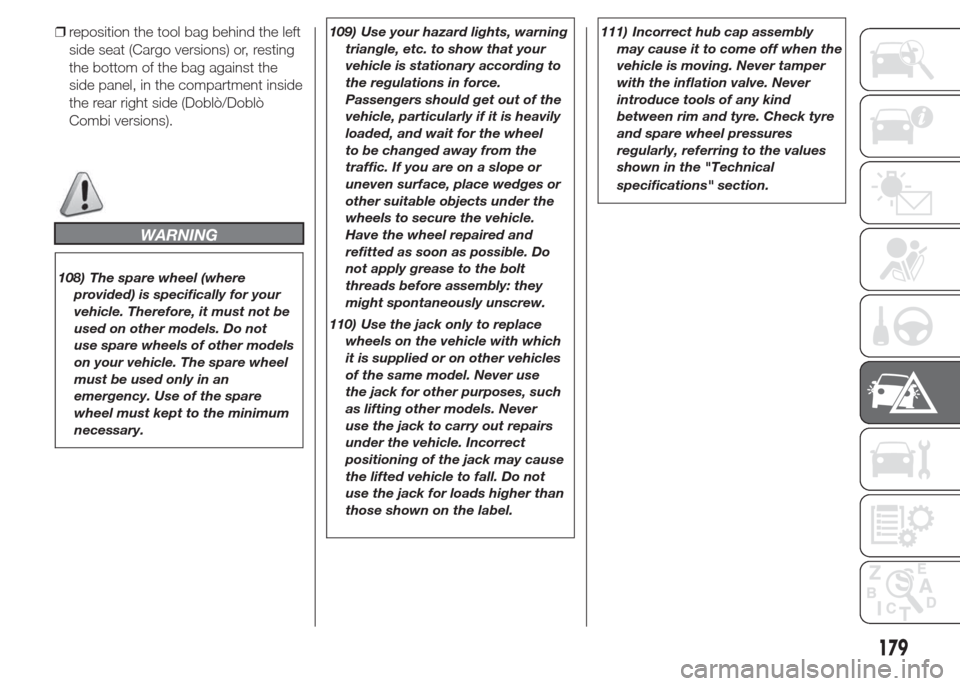
❒reposition the tool bag behind the left
side seat (Cargo versions) or, resting
the bottom of the bag against the
side panel, in the compartment inside
the rear right side (Doblò/Doblò
Combi versions).
WARNING
108) The spare wheel (where
provided) is specifically for your
vehicle. Therefore, it must not be
used on other models. Do not
use spare wheels of other models
on your vehicle. The spare wheel
must be used only in an
emergency. Use of the spare
wheel must kept to the minimum
necessary.109) Use your hazard lights, warning
triangle, etc. to show that your
vehicle is stationary according to
the regulations in force.
Passengers should get out of the
vehicle, particularly if it is heavily
loaded, and wait for the wheel
to be changed away from the
traffic. If you are on a slope or
uneven surface, place wedges or
other suitable objects under the
wheels to secure the vehicle.
Have the wheel repaired and
refitted as soon as possible. Do
not apply grease to the bolt
threads before assembly: they
might spontaneously unscrew.
110) Use the jack only to replace
wheels on the vehicle with which
it is supplied or on other vehicles
of the same model. Never use
the jack for other purposes, such
as lifting other models. Never
use the jack to carry out repairs
under the vehicle. Incorrect
positioning of the jack may cause
the lifted vehicle to fall. Do not
use the jack for loads higher than
those shown on the label.111) Incorrect hub cap assembly
may cause it to come off when the
vehicle is moving. Never tamper
with the inflation valve. Never
introduce tools of any kind
between rim and tyre. Check tyre
and spare wheel pressures
regularly, referring to the values
shown in the "Technical
specifications" section.
179
Page 184 of 323
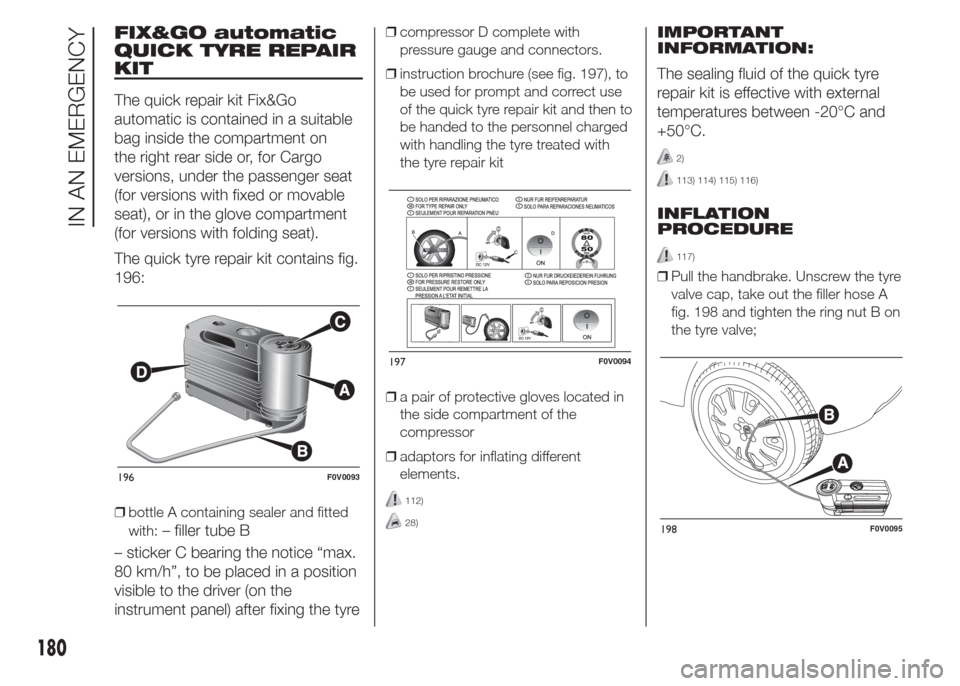
FIX&GO automatic
QUICK TYRE REPAIR
KIT
The quick repair kit Fix&Go
automatic is contained in a suitable
bag inside the compartment on
the right rear side or, for Cargo
versions, under the passenger seat
(for versions with fixed or movable
seat), or in the glove compartment
(for versions with folding seat).
The quick tyre repair kit contains fig.
196:
❒bottle A containing sealer and fitted
with:
– filler tube B
– sticker C bearing the notice “max.
80 km/h”, to be placed in a position
visible to the driver (on the
instrument panel) after fixing the tyre
❒compressor D complete with
pressure gauge and connectors.
❒instruction brochure (see fig. 197), to
be used for prompt and correct use
of the quick tyre repair kit and then to
be handed to the personnel charged
with handling the tyre treated with
the tyre repair kit
❒a pair of protective gloves located in
the side compartment of the
compressor
❒adaptors for inflating different
elements.
112)
28)
IMPORTANT
INFORMATION:
The sealing fluid of the quick tyre
repair kit is effective with external
temperatures between -20°C and
+50°C.
2)
113) 114) 115) 116)
INFLATION
PROCEDURE
117)
❒Pull the handbrake. Unscrew the tyre
valve cap, take out the filler hose A
fig. 198 and tighten the ring nut B on
the tyre valve;
196F0V0093
197F0V0094
198F0V0095
180
IN AN EMERGENCY
Page 185 of 323
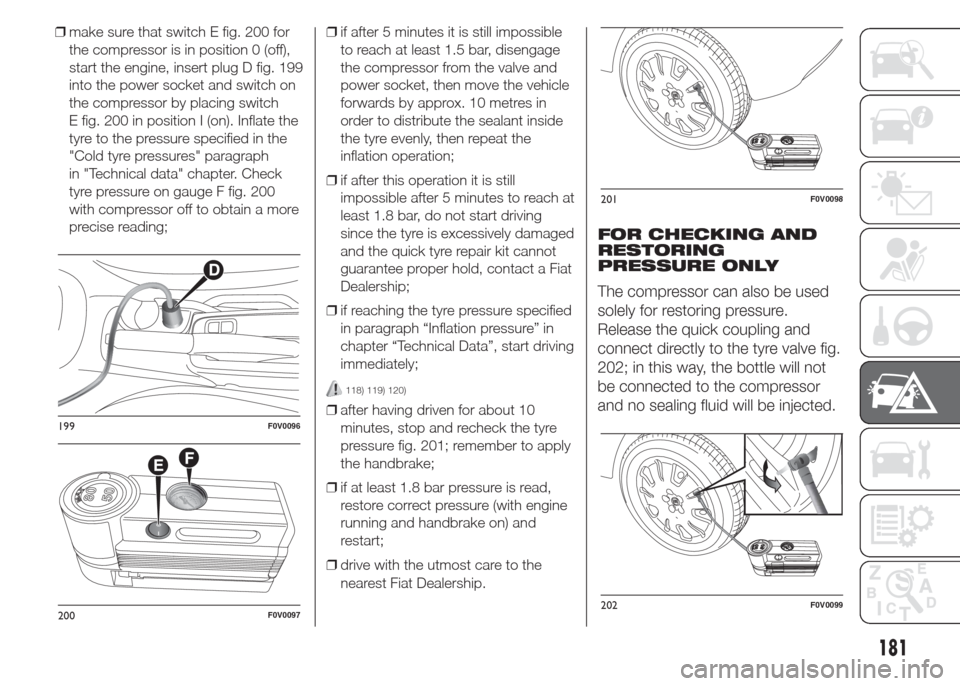
❒make sure that switch E fig. 200 for
the compressor is in position 0 (off),
start the engine, insert plug D fig. 199
into the power socket and switch on
the compressor by placing switch
E fig. 200 in position I (on). Inflate the
tyre to the pressure specified in the
"Cold tyre pressures" paragraph
in "Technical data" chapter. Check
tyre pressure on gauge F fig. 200
with compressor off to obtain a more
precise reading;❒if after 5 minutes it is still impossible
to reach at least 1.5 bar, disengage
the compressor from the valve and
power socket, then move the vehicle
forwards by approx. 10 metres in
order to distribute the sealant inside
the tyre evenly, then repeat the
inflation operation;
❒if after this operation it is still
impossible after 5 minutes to reach at
least 1.8 bar, do not start driving
since the tyre is excessively damaged
and the quick tyre repair kit cannot
guarantee proper hold, contact a Fiat
Dealership;
❒if reaching the tyre pressure specified
in paragraph “Inflation pressure” in
chapter “Technical Data”, start driving
immediately;
118) 119) 120)
❒after having driven for about 10
minutes, stop and recheck the tyre
pressure fig. 201; remember to apply
the handbrake;
❒if at least 1.8 bar pressure is read,
restore correct pressure (with engine
running and handbrake on) and
restart;
❒drive with the utmost care to the
nearest Fiat Dealership.
FOR CHECKING AND
RESTORING
PRESSURE ONLY
The compressor can also be used
solely for restoring pressure.
Release the quick coupling and
connect directly to the tyre valve fig.
202; in this way, the bottle will not
be connected to the compressor
and no sealing fluid will be injected.
199F0V0096
200F0V0097
201F0V0098
202F0V0099
181
Page 186 of 323
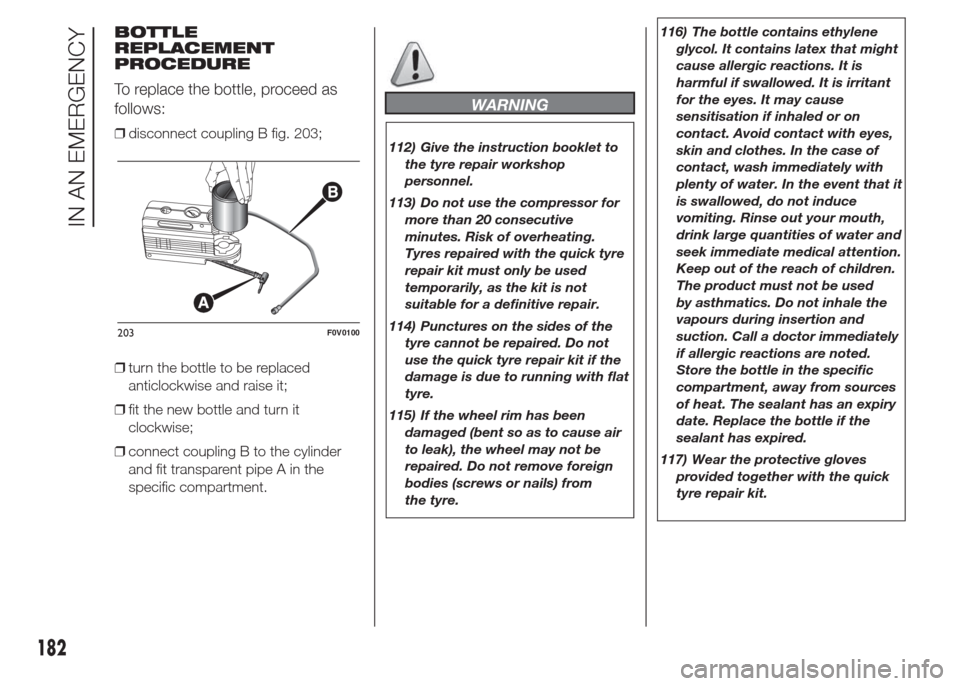
BOTTLE
REPLACEMENT
PROCEDURE
To replace the bottle, proceed as
follows:
❒disconnect coupling B fig. 203;
❒turn the bottle to be replaced
anticlockwise and raise it;
❒fit the new bottle and turn it
clockwise;
❒connect coupling B to the cylinder
and fit transparent pipe A in the
specific compartment.
WARNING
112) Give the instruction booklet to
the tyre repair workshop
personnel.
113) Do not use the compressor for
more than 20 consecutive
minutes. Risk of overheating.
Tyres repaired with the quick tyre
repair kit must only be used
temporarily, as the kit is not
suitable for a definitive repair.
114) Punctures on the sides of the
tyre cannot be repaired. Do not
use the quick tyre repair kit if the
damage is due to running with flat
tyre.
115) If the wheel rim has been
damaged (bent so as to cause air
to leak), the wheel may not be
repaired. Do not remove foreign
bodies (screws or nails) from
the tyre.116) The bottle contains ethylene
glycol. It contains latex that might
cause allergic reactions. It is
harmful if swallowed. It is irritant
for the eyes. It may cause
sensitisation if inhaled or on
contact. Avoid contact with eyes,
skin and clothes. In the case of
contact, wash immediately with
plenty of water. In the event that it
is swallowed, do not induce
vomiting. Rinse out your mouth,
drink large quantities of water and
seek immediate medical attention.
Keep out of the reach of children.
The product must not be used
by asthmatics. Do not inhale the
vapours during insertion and
suction. Call a doctor immediately
if allergic reactions are noted.
Store the bottle in the specific
compartment, away from sources
of heat. The sealant has an expiry
date. Replace the bottle if the
sealant has expired.
117) Wear the protective gloves
provided together with the quick
tyre repair kit.
203F0V0100
182
IN AN EMERGENCY
Page 187 of 323
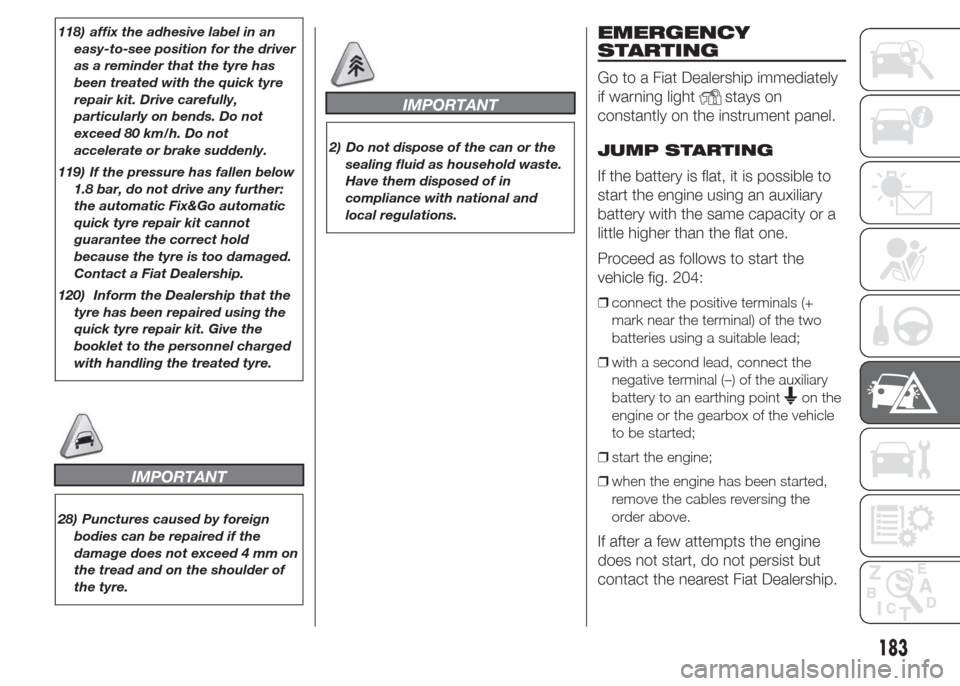
118) affix the adhesive label in an
easy-to-see position for the driver
as a reminder that the tyre has
been treated with the quick tyre
repair kit. Drive carefully,
particularly on bends. Do not
exceed 80 km/h. Do not
accelerate or brake suddenly.
119) If the pressure has fallen below
1.8 bar, do not drive any further:
the automatic Fix&Go automatic
quick tyre repair kit cannot
guarantee the correct hold
because the tyre is too damaged.
Contact a Fiat Dealership.
120) Inform the Dealership that the
tyre has been repaired using the
quick tyre repair kit. Give the
booklet to the personnel charged
with handling the treated tyre.
IMPORTANT
28) Punctures caused by foreign
bodies can be repaired if the
damage does not exceed 4 mm on
the tread and on the shoulder of
the tyre.
IMPORTANT
2) Do not dispose of the can or the
sealing fluid as household waste.
Have them disposed of in
compliance with national and
local regulations.
EMERGENCY
STARTING
Go to a Fiat Dealership immediately
if warning light
stays on
constantly on the instrument panel.
JUMP STARTING
If the battery is flat, it is possible to
start the engine using an auxiliary
battery with the same capacity or a
little higher than the flat one.
Proceed as follows to start the
vehicle fig. 204:
❒connect the positive terminals (+
mark near the terminal) of the two
batteries using a suitable lead;
❒with a second lead, connect the
negative terminal (–) of the auxiliary
battery to an earthing point
on the
engine or the gearbox of the vehicle
to be started;
❒start the engine;
❒when the engine has been started,
remove the cables reversing the
order above.
If after a few attempts the engine
does not start, do not persist but
contact the nearest Fiat Dealership.
183
Page 188 of 323
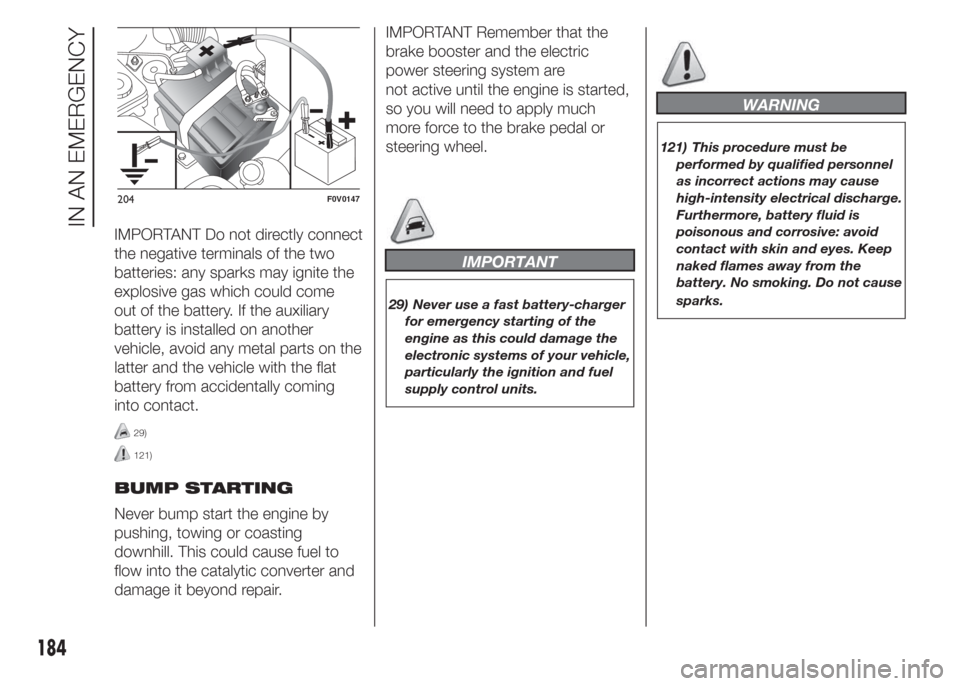
IMPORTANT Do not directly connect
the negative terminals of the two
batteries: any sparks may ignite the
explosive gas which could come
out of the battery. If the auxiliary
battery is installed on another
vehicle, avoid any metal parts on the
latter and the vehicle with the flat
battery from accidentally coming
into contact.
29)
121)
BUMP STARTING
Never bump start the engine by
pushing, towing or coasting
downhill. This could cause fuel to
flow into the catalytic converter and
damage it beyond repair.IMPORTANT Remember that the
brake booster and the electric
power steering system are
not active until the engine is started,
so you will need to apply much
more force to the brake pedal or
steering wheel.
IMPORTANT
29) Never use a fast battery-charger
for emergency starting of the
engine as this could damage the
electronic systems of your vehicle,
particularly the ignition and fuel
supply control units.
WARNING
121) This procedure must be
performed by qualified personnel
as incorrect actions may cause
high-intensity electrical discharge.
Furthermore, battery fluid is
poisonous and corrosive: avoid
contact with skin and eyes. Keep
naked flames away from the
battery. No smoking. Do not cause
sparks.
204F0V0147
184
IN AN EMERGENCY
Page 189 of 323

FUEL CUT-OFF
SYSTEM
This intervenes in the case of an
impact causing:
❒the fuel supply cut-off with the engine
consequently switching off;
❒the automatic unlocking of the doors;
❒the switching on of the interior lights;
❒switching on of the hazard warning
lights (to deactivate the lights press
the dedicated button on the
dashboard).
122)
When the system has been
triggered, the message “Fuel cut off,
see handbook” is displayed on
some versions.
Check carefully for fuel leaks, for
instance in the engine compartment,
under the vehicle or near the tank
area.
After a collision, turn the ignition key
to STOP to prevent the battery
from running down.
The following procedure should be
carried out to restore the correct
operation of the vehicle:
❒turn the ignition key to the MAR
position;❒activate the right direction indicator;
❒deactivate the right direction
indicator;
❒activate the left direction indicator;
❒deactivate the left direction indicator;
❒activate the right direction indicator;
❒deactivate the right direction
indicator;
❒activate the left direction indicator;
❒deactivate the left direction indicator;
❒turn the ignition key to the OFF
position.
WARNING
122) If, after an impact, you smell
fuel or notice leaks from the fuel
supply system, do not reactivate
the system to avoid the risk of fire.
LIFTING THE
VEHICLE
If the vehicle needs to be lifted, go
to a Fiat Dealership which is
equipped with the arm hoist or
workshop lift.
185
Page 190 of 323
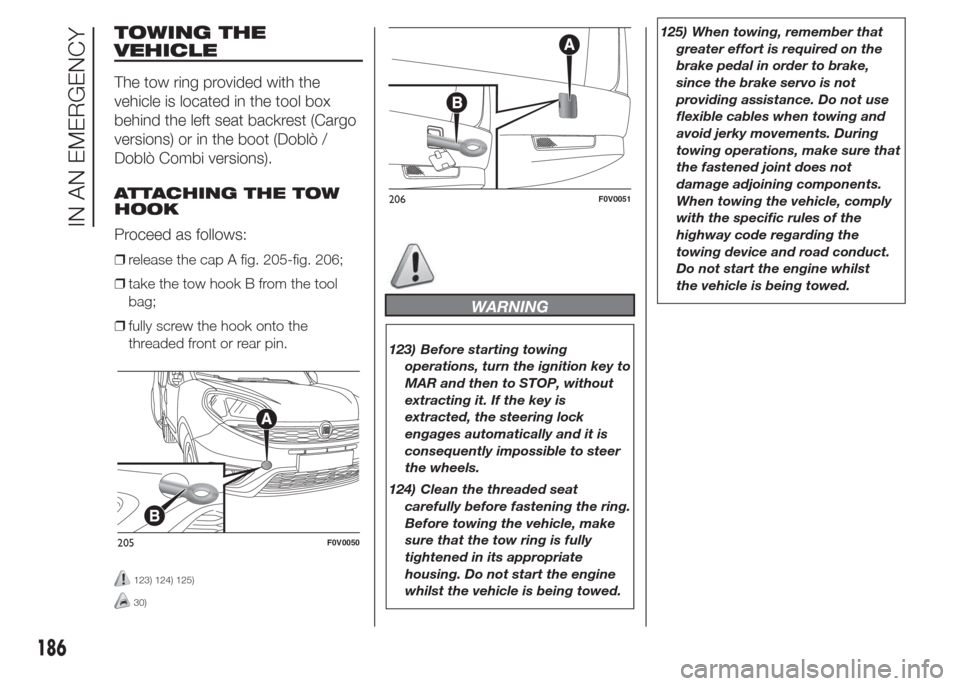
TOWING THE
VEHICLE
The tow ring provided with the
vehicle is located in the tool box
behind the left seat backrest (Cargo
versions) or in the boot (Doblò /
Doblò Combi versions).
ATTACHING THE TOW
HOOK
Proceed as follows:
❒release the cap A fig. 205-fig. 206;
❒take the tow hook B from the tool
bag;
❒fully screw the hook onto the
threaded front or rear pin.
123) 124) 125)
30)
WARNING
123) Before starting towing
operations, turn the ignition key to
MAR and then to STOP, without
extracting it. If the key is
extracted, the steering lock
engages automatically and it is
consequently impossible to steer
the wheels.
124) Clean the threaded seat
carefully before fastening the ring.
Before towing the vehicle, make
sure that the tow ring is fully
tightened in its appropriate
housing. Do not start the engine
whilst the vehicle is being towed.125) When towing, remember that
greater effort is required on the
brake pedal in order to brake,
since the brake servo is not
providing assistance. Do not use
flexible cables when towing and
avoid jerky movements. During
towing operations, make sure that
the fastened joint does not
damage adjoining components.
When towing the vehicle, comply
with the specific rules of the
highway code regarding the
towing device and road conduct.
Do not start the engine whilst
the vehicle is being towed.
205F0V0050
206F0V0051
186
IN AN EMERGENCY